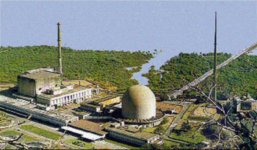CIRUS and DHRUVA Reactors, Trombay
These two reactors can provide India with perhaps 30 to 35 kilograms of plutonium each year. Depending on the sophistication of the weapon design, this might be sufficient for between four to eight nuclear weapons each year.
Plutonium for nuclear weapons, which is also the fuel for the second stage reactors of the Indian nuclear power program, is obtained from spent uranium fuel of PHWRs. Fuel reprocessing aims at recovering the reusable fissile and fertile component of the spent fuel. Fuel reprocessing started in India at a time when it was regarded as an exclusively nuclear weapon related activity. Understandably, no collaboration was forthcoming in this field and so India had to develop this technology entirely by indigenous efforts.
Reprocessing of spent fuel was started with the commissioning of a 30 tonne per annum plant at Trombay in 1964. The Trombay Fuel Reprocessing Plant reprocesses natural uranium metal fuels. The design basis includes chemical declad, PUREX flowsheet and contact maintenance, with a capacity of 0.1-0.15 tHM/d. Plutonium from CIRUS was chemically separated from irradiated uranium fuel in the Trombay plutonium separation plant which began operating in 1964. This separation facility was shut down in 1974, and was enlarged and re-opened in the early 1980s.
Based on the experience gained at Trombay, a fuel reprocessing plant PREFRE was set up at Tarapur. In India today there are three reprocessing plants to extract Plutonium from spent fuel, one at Trombay, the second at Tarapur and recently the third one was cold commissioned at Kalpakkam. It is understood that only the Trombay reprocessing facility is used to support the Indian nuclear weapons program, while the Tarapur facility is associated with the civilian nuclear power program.
For upgrading the used degraded heavy water from research reactors, a Heavy Water Reconcentration facility was set up at Trombay in 1962. Based on this experience, BARC has developed heavy water upgrading technology and at present 20 reconcentration towers are in operation at various sites.
It is reported that indigenously enriched uranium was used in the two low-yield weapons tested in 1998, leading to speculation that the material may have been obtained from the Rare Materials Plant in Mysore, site of BARC's uranium enrichment plant, or possibly from the Fast Breeder Test Reactor (FBTR) project at the Indira Gandhi Centre for Atomic Research (IGCAR) in Kalpakkam. However, most [if not all] of the fissile material used in the tests was probably plutonium from BARC in Trombay.
| Ground Truth Imagery of the Bhabha Atomic Research Centre, Trombay
|
||

|

| |
| No. | Item | Description | |
| CIRUS | DHRUVA | ||
| 1 | Reactor Type | Tank type | Tank type |
| 2 | Date of Criticality | July 10,1960 | August 8,1985 |
| 3 | Reactor Power | 40 MW(Maximum) | 100 MW(Maximum) |
| 4 | Fuel Material | Natural Uranium | Natural Uranium |
| 5 | Fuel Element | Rods | Rods |
| 6 | Fuel Cladding | Aluminium | Aluminium |
| 7 | Total weight of Fuel | 10.5 T | 6.61 T |
| 8 | Core Size | 3.14m(H)x2.67m (D) | 3.87m(H)x3.72m(D) |
| 9 | Max Neutron Flux Density | (6.7)*13 | 1.8x10.0E+14 |
| 10 | Moderator | Heavy water | Heavy water |
| 11 | Coolant | Light water | Heavy water |
| 12 | Control Rods | Boron Cadmium | Cadmium |
| 13 | Uses | Isotopes production;R & D in reactor technology;operator training | Basic research; reactor technology;isotope production; training |

|
NEWSLETTER
|
| Join the GlobalSecurity.org mailing list |
|
|
|

